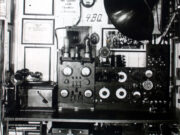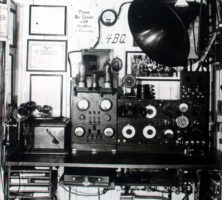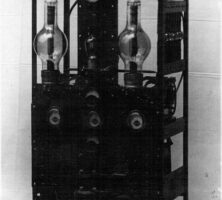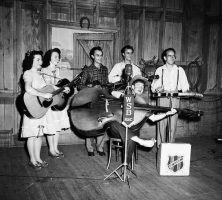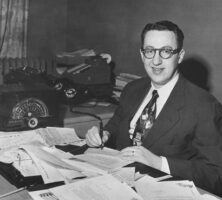Commercial radio broadcasting in Georgia began on March 15, 1922, when a hastily assembled transmission system began scheduled broadcasting under the call letters WSB. This was the first true station in the state and the forerunner of more than 450 stations to come.
Origins
Since about 1900 “electric radio signals” had crossed Georgia’s skies, but only amateur radio enthusiasts, experimenters, and ships had found use for the airwaves. Many Georgians built homemade devices to trap the elusive signals. Crude parts included basket-woven wires to separate frequencies, and tiny crystals touched by a thin “cat’s whisker” wire to detect the radio energy. Homebuilt radios often employed wires wrapped around an oatmeal container. In the beginning, batteries made from acid and metal contained in glass home-canning jars provided power. Simple earphones were made by winding wire around an iron core and placing the center of a thin metal disk against the end of the core. Feeding an amplified audio circuit from the radio into the wires caused the disk to vibrate in tune with the signal.
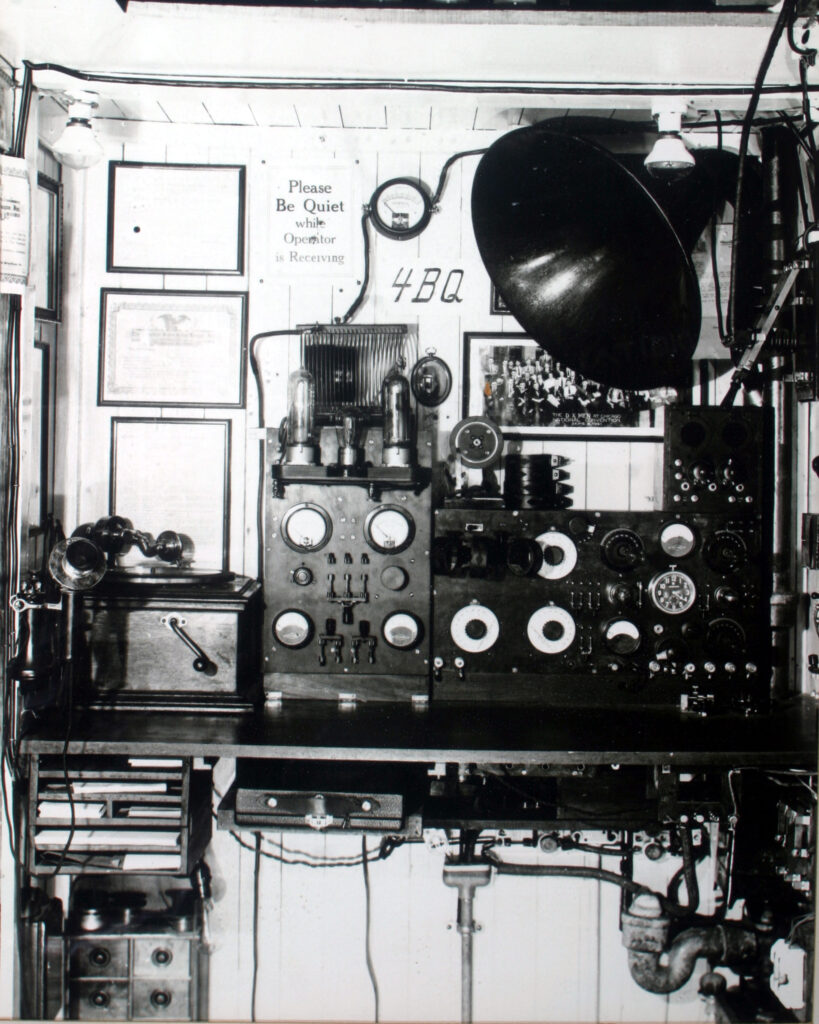
Courtesy of Michael H. McDougald
Rival Atlanta newspapers (the Journal and the Constitution) each pushed to be first on the air with commercial radio. The Atlanta Journal hired engineers George Iler and Walter Tison to start a station. In mid-March 1922 they placed a phone call to Gordon Hight of Rome, who sold them his transmitter just in time to make radio history. On the Forsyth Street roof of the Journal building, under a wire antenna strung from two wooden masts, Georgia’s first licensed commercial station, WSB, took to the air on March 15 with just 100 watts of power. Ice was used to cool the heat generated by the batteries.
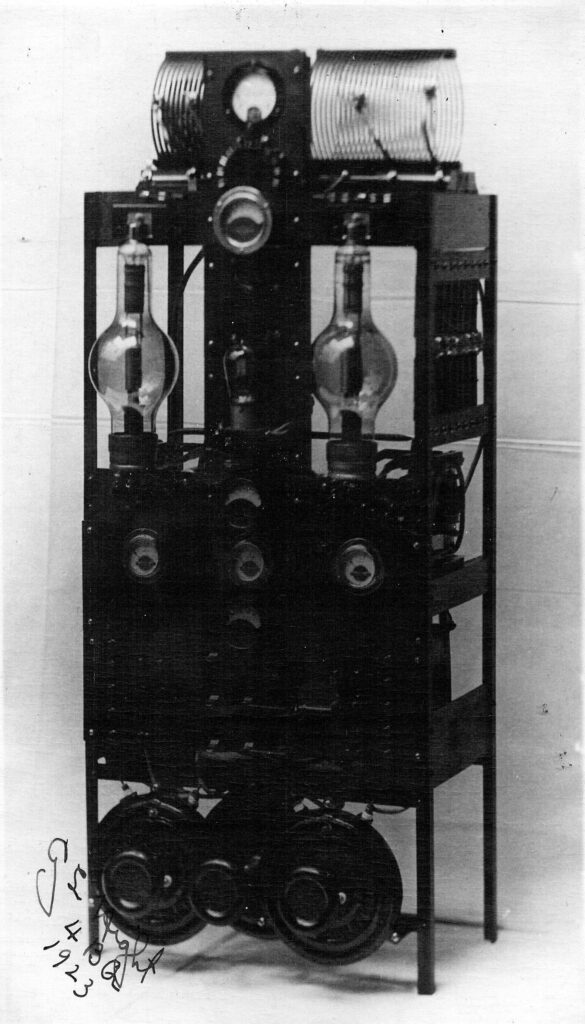
Courtesy of Michael H. McDougald
Following WSB onto the airwaves in 1922 were five other stations, four of which served the Atlanta area. They were WAAS in Decatur, WGM in Atlanta (later WGST at the Georgia Institute of Technology), WDAJ in College Park, WDAW in Atlanta, and WGAV in Savannah. Hoyt Wimpy of Thomasville worked the amateur airwaves and years later pioneered Georgia’s seventh station, WPAX. Other early broadcasters were WTOC in Savannah; WMAZ in Macon; WRDW in Augusta; WRBL in Columbus; WFDV (later WRGA) in Rome; and WTFI for Toccoa Falls Institute, a station that ultimately moved to Athens.
Call Letters
Call letters may or may not have meaning. Listeners more easily remember a call when it is accompanied by a slogan. Pioneers Lambdin Kay and Ernie Rogers of WSB suggested that their station’s call letters stood for “Welcome South, Brother.” WTOC aided tourism in Savannah with “Welcome to Our City.” Macon saluted its leading college with WMAZ’s “Watch Mercer Attain Zenith.” In Columbus, WGBA stood for “Where Georgia Borders Alabama.” WGIG in Brunswick saluted the “Golden Isles of Georgia,” and WMOG celebrated the “Marshes of Glynn.” In Atlanta, WPCH denoted Georgia’s great agricultural product, the peach. Atlanta’s WAKE suggested waking up to hear the radio.
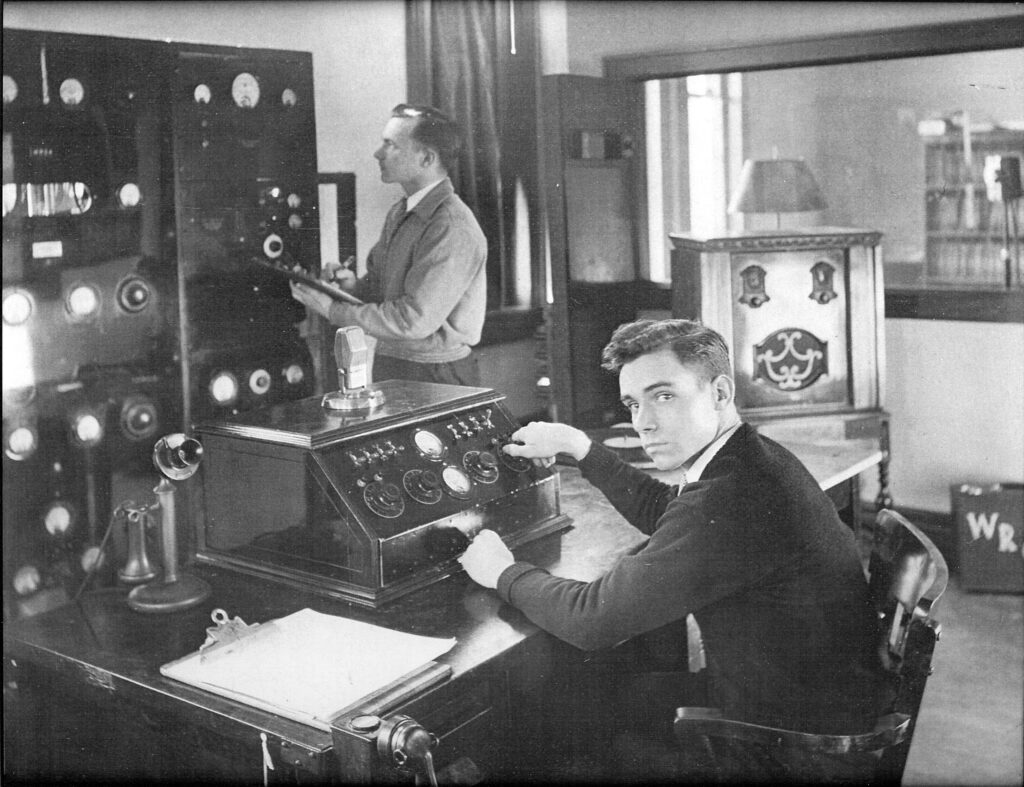
Courtesy of Michael H. McDougald
Through the years, other stations have incorporated their call letters with the home city’s name, such as WAGA and WATL in Atlanta, WGGA in Gainesville, WALB in Albany, and WROM and WRGA in Rome. Three Athens stations, WGAU, WUGA, and WUOG, mark the presence of the state university in that city.
New Services, More Radios, More Listeners
The growth of stations spurred the manufacturing of AM (amplitude modulation) radio sets. As more listeners tuned in, many stations prospered. By the mid-1930s some automobiles featured radios, and visionaries were looking ahead to adding television, FM (frequency modulation), or perhaps the facsimile printing of “news” on rolls of treated paper. It would be 1948 before TV arrived, however, and the 1970s before FM realized its potential; when facsimile printing was finally developed, it was not based on broadcast technology.
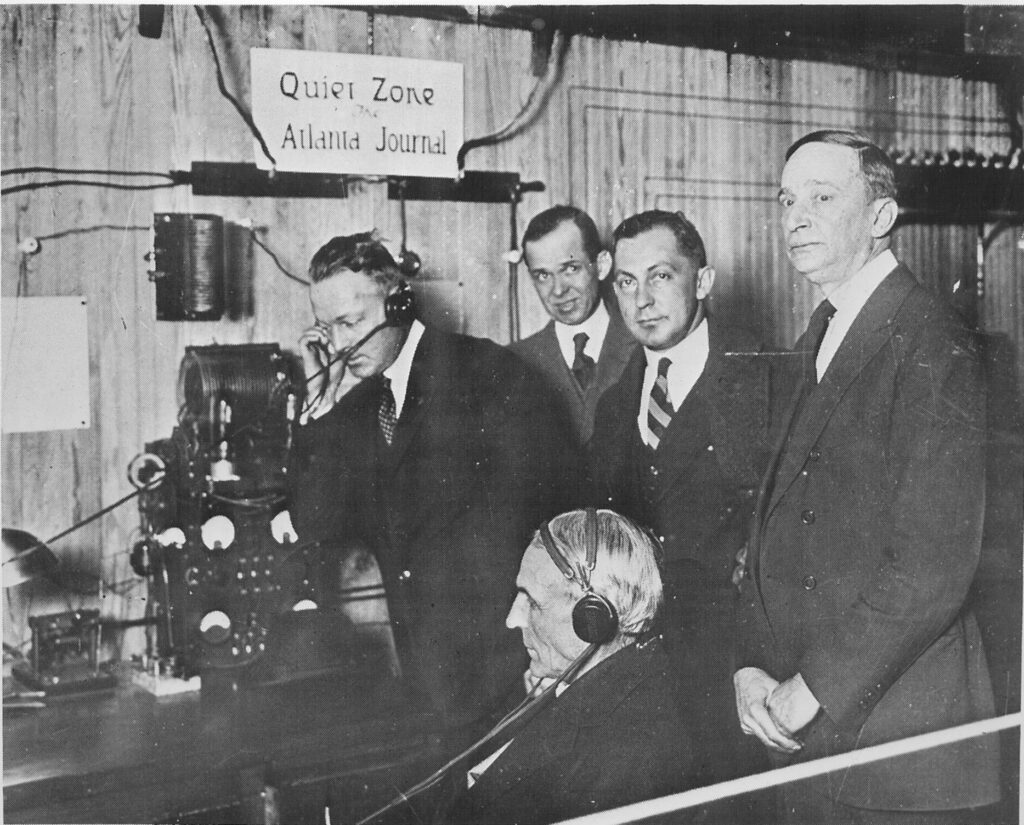
Courtesy of Michael H. McDougald
While FM first appeared in the 1930s, in actual practice most radio tuners tended to drift off the station. However, with its wider band width and higher technical quality, FM began to offer mostly classical music, heard without static. Technical improvements of the 1960s enabled FM stations to blossom, and they began to play popular songs, rock, and country; by 2000, most FMs programmed music, talk, news, and ethnic features. Those developments, together with changes in Federal Communications Commission (FCC) rules, greatly increased the value of FM stations, and some in Georgia have been sold for as much as $250 million. While the value of AM stations tended to diminish during the last decade, the current trend is upward.
WSB applied for Georgia’s first television license in 1931, but TV receivers were extremely crude and virtually nonexistent. (They featured a spinning wheel with tiny holes through which projected light shone to a surface, creating a picture.) It was 1948 before the first TV station in Georgia actually went on the air.
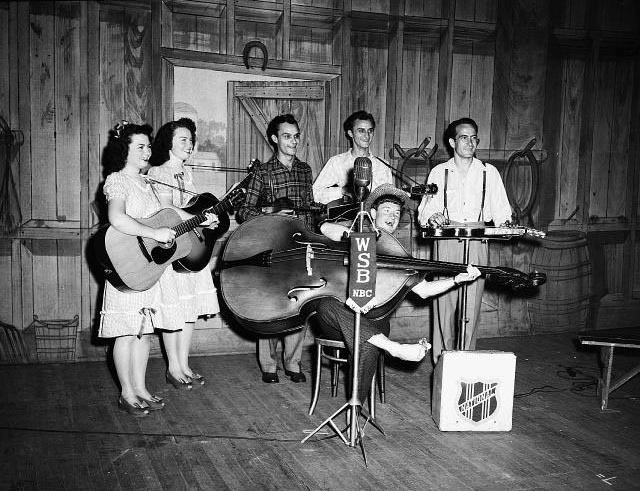
Courtesy of Special Collections & Archives, Georgia State University Library.
In 1933 the University of Georgia (UGA) developed statewide Georgia Bulldog football coverage on pioneering Georgia stations. Georgia Tech followed with its own network. The names of legendary sports commentators Marcus Bartlett, “Red” Cross, Al Ciraldo, and Larry Munson are remembered by thousands of radio listeners.
World War II and the Postwar Era
World War II (1941-45) slowed the overall growth of broadcasting. War news led to the development of new listening patterns, as radio reported instantly from around the world. After the war, as returning servicemen sought jobs and opportunity, Georgia radio experienced a tremendous growth in licenses. Small towns developed their own stations and tailored their small coverage areas to hometown news and local fare. Small-power operations covering about a thirty-mile radius popped up in virtually every small town in Georgia.

Courtesy of Special Collections & Archives, Georgia State University Library.
In 1947 the tiny transistor made its appearance, decreasing both the size and the power consumption of radios and thereby changing the history of broadcasting. Millions of sets were produced, and radio moved from the “living room” into virtually every room in the house. Automobile listening increased as well. Newstations were added, and these properties took on dollar values far beyond any earlier dreams.
In 1948 the FCC authorized WABE-FM, which was owned by the Atlanta Board of Education, to begin broadcasting. This was Georgia’s first station devoted purely to educational programming. School systems began to formulate broadcasting as an extension of their services, and a public broadcasting net began to form in the state. A network of public radio stations, many of which are affiliated with colleges and universities, now offers National Public Radio programming as well as classical music and local features.
Georgia Association of Broadcasters
Georgia broadcasters were early to develop their own broadcasting association and, thanks to strong support, the Georgia Association of Broadcasters (GAB) was founded in 1935 and became the nation’s largest, and one of the most active, state associations. GAB has enjoyed a long history of association with the Henry W. Grady College of Journalism and Mass Communications at UGA and has developed unique working relationships with numerous other colleges and universities around the state. The Georgia Broadcasting Hall of Fame, housed at UGA, recognizes those who have made substantial contributions to Georgia broadcasting. Likewise, the nation’s most prestigious broadcasting awards, the Peabodys, are administered by the Grady College of Journalism.
Meeting the Challenge of Newer Technologies
During the early 1950s, with television encroaching on audiences, budget, and talent, a Georgia radio broadcaster developed a nationwide campaign to resurrect the medium. Elmo Ellis used the platform “Removing the Rust from Radio” to encourage all American stations to make strong efforts to revitalize their operations. The movement was considered to be very successful with Ellis, a Peabody Award–winning executive, at the helm.
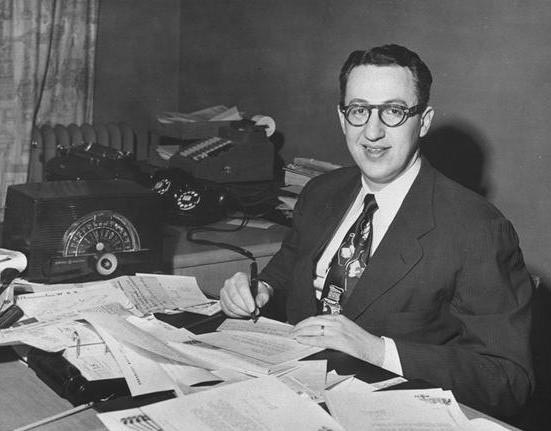
Courtesy of History of WSB Radio
By 2003 the FCC had licensed 448 Georgia stations. Trends in ownership are changing because of a more liberal FCC policy, with some companies owning dozens of stations within the state. Just after 2000, satellite radio networks appeared, and new technology allowed satellite signals to reach moving cars.
Some observers have questioned whether traditional radio can survive in this technological environment, but radio is now enjoying its greatest prosperity. Radio broadcasting in Georgia has emulated the tremendous pattern of growth within the state. With about 8.5 million potential listeners, and thousands more in neighboring states, Georgia stations offer programming as diverse as the population itself.


